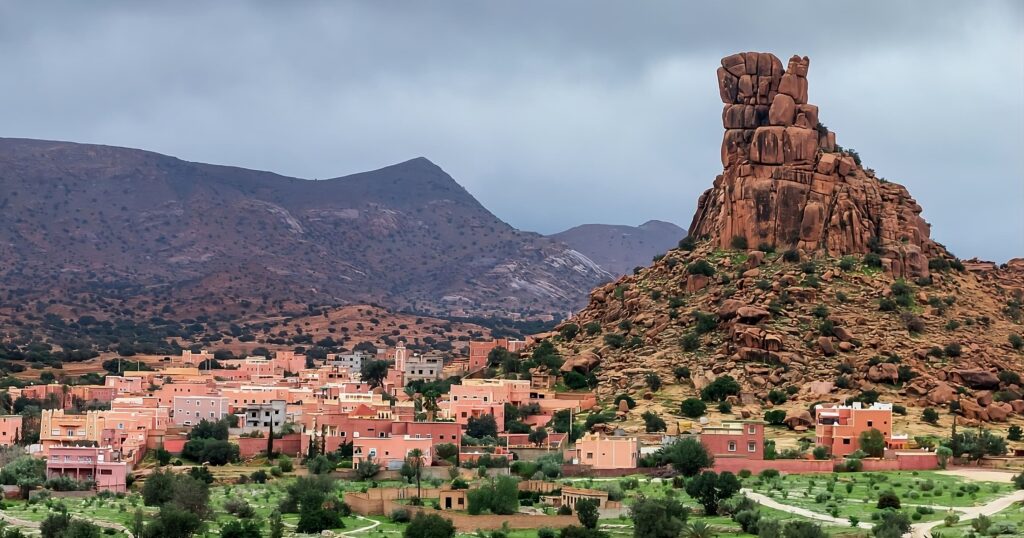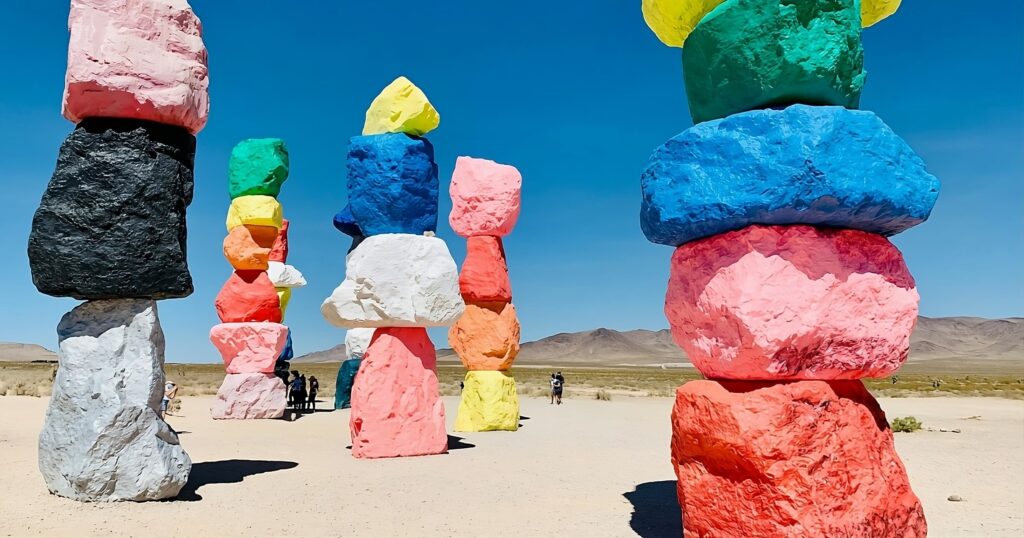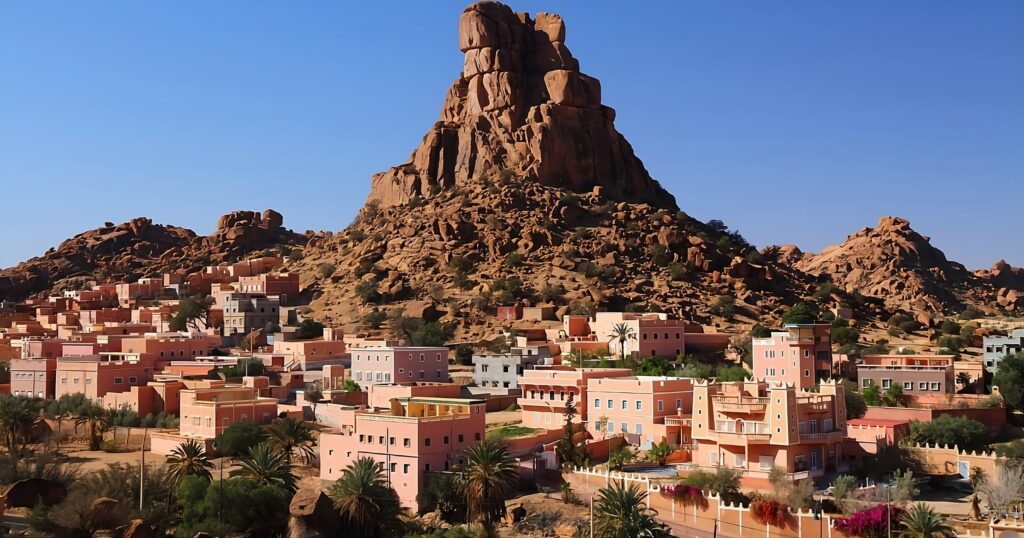Nestled deep within Morocco’s breathtaking Anti-Atlas Mountains, Tafraout is one of the country’s most enchanting hidden gems. While travelers often flock to bustling Marrakech and Fes, this serene oasis town offers something truly unique: towering pink granite rock formations that glow like fiery embers at sunset, an authentic Berber culture untouched by mass tourism, and valleys that burst into stunning clouds of white and pink almond blossoms each spring.

This small mountain town, sitting at 1,200 meters above sea level, provides a peaceful escape where the rhythm of traditional life continues unchanged. Here, you’ll find yourself surrounded by dramatic landscapes that seem almost otherworldly, warm hospitality from the local Amazigh (Berber) community, and an authenticity that’s becoming increasingly rare in Morocco’s tourist destinations.
Table of Contents
| Getting There |
| Best Time to Visit |
| Top Things to Do in Tafraout |
| Where to Stay |
| What to Eat |
| Cultural Tips |
| Why Tafraout is Worth Visiting |
| Final Travel Tips |
| Conclusion |
| FAQ |
Getting There
From Agadir (150km, 2.5-3 hours): The most common route takes you through the scenic Sous Valley. Head northeast on the N10 toward Ait Melloul, then follow the R104 through Tiznit before taking the R104 mountain road to Tafraout. The drive to Tafraout rewards travelers with breathtaking panoramic views, though it features winding mountain roads that add both adventure and authenticity to the journey.
From Tiznit (110km, 2 hours): take the scenic R104 route through the breathtaking Anti-Atlas Mountains for an unforgettable southern Morocco journey. It’s slightly shorter but equally mountainous.
From Marrakech (350km, 5-6 hours): Take the N8 toward Agadir, then follow the Agadir route above. This makes for a long day drive but offers incredible scenery.
Transportation Options:
- Rental Car: The most flexible option, essential for exploring surrounding villages and viewpoints. Ensure you’re comfortable with mountain driving and have a GPS or offline maps.
- Bus: CTM and Supratours run services from major cities, though schedules can be limited and journeys take longer.
- Guided Tours: Many operators in Agadir and Marrakech offer multi-day trips including accommodation and meals.
- Grand Taxi: Shared taxis from Tiznit are an authentic local experience, though less comfortable for longer distances.
Best Time to Visit
February to March: Tafraout’s most enchanting season is the almond blossom bloom, usually peaking mid-February, drawing nature lovers and photographers alike. The entire Ameln Valley transforms into a sea of pink and white flowers against the dramatic red rocks – a photographer’s paradise and one of Morocco’s most beautiful natural spectacles.
October to April: These months offer the most comfortable weather for hiking and exploration, with daytime temperatures ranging from 15-25°C (59-77°F) and cool, crisp evenings perfect for stargazing.
Summer (June-August): Can be quite hot during the day (often exceeding 35°C/95°F), but the mountain elevation keeps it more bearable than desert regions. Early morning and evening activities are recommended.
Avoid: Late summer can see occasional flash floods in the valleys, and winter nights can be surprisingly cold, sometimes dropping near freezing.

Top Things to Do in Tafraout
Explore the Painted Rocks (Les Roches Peintes)
About 3km from town, Belgian artist Jean Vérame created this surreal outdoor art installation in 1984, painting massive granite boulders in brilliant blues and purples. While some paint has faded over the decades, the rocks remain a striking contrast against the natural landscape. The site is easily reachable by car or scenic walk, with sunset offering stunning views and magical golden light.
Discover Traditional Berber Villages
The Ameln Valley surrounding Tafraout is dotted with 26 traditional villages, each with its own character:
- Oumesnate: Known for its ancient granaries carved into cliffsides
- Adai: Features traditional Berber architecture and terraced gardens
- Taghdichte: Offers panoramic valley views and hiking trails
- Afensou: Known for striking rock formations and artisanal crafts
Many villages welcome respectful visitors and offer insights into traditional Amazigh life, including ancient irrigation systems and architectural techniques passed down through generations.
Hiking and Biking in the Ameln Valley
The valley offers endless opportunities for outdoor enthusiasts:
- Napoleon’s Hat (Chapeau de Napoléon): This iconic rock formation, shaped like the emperor’s bicorne hat, is a must-see landmark, reachable via a scenic 2-hour moderate hike in the Anti-Atlas Mountains
- Jebel Lekst: The highest peak in the area (2,359m), offering challenging day hikes with spectacular panoramic views
- Valley Floor Walks: Gentle paths through palm groves, almond orchards, and traditional villages
- Rock Climbing: The granite formations provide excellent climbing opportunities for experienced climbers
| Our offers |
|---|
| Tafraoute the Anti Atlas Day trip |
| Tafraout: Mountain Bike Tour |
| Agadir: Day-Trip to Tafraout in the Anti-Atlas |
Shopping for Local Crafts
Tafraout’s weekly souk (market day is Wednesday) and small shops offer authentic Berber crafts:
- Babouches: Handmade leather slippers in traditional styles and vibrant colors
- Silver Jewelry: Intricate Amazigh designs including traditional fibulas (decorative clasps) and bracelets
- Argan Oil Products: Locally produced cosmetic and culinary argan oil
- Textiles: Hand-woven carpets and traditional clothing
- Pottery: Local ceramics with distinctive geometric patterns
Where to Stay
Budget Options (Under 300 MAD/night)
- Auberge Tangana: A family-run guesthouse with basic but clean rooms and home-cooked meals
- Hotel Tafraout: Simple accommodations in the town center with mountain views
Mid-Range (300-800 MAD/night)
- Maison d’Hôtes Chez Amaliya: Charming traditional house with comfortable rooms and excellent local cuisine
- Auberge Le Safran: Cozy mountain lodge with panoramic terraces and organized hiking excursions
- Hotel Les Amandiers: Popular Tafraout hotel offering a pool, restaurant, and scenic gardens
Boutique/Luxury (800+ MAD/night)
- Riad Jnane Imlil: Restored traditional riad with modern comforts, offering breathtaking High Atlas Mountain views
- Dar Infiane: Eco-lodge emphasizing sustainable tourism and authentic cultural experiences
- Villa Quiet: Upscale accommodation with private terraces and personalized service
What to Eat
Tafraout’s cuisine reflects its Berber heritage and mountain location, featuring fresh, simple ingredients prepared with traditional techniques.
Must-Try Dishes
- Berber Tagine: Slow-cooked stews with tender meat, vegetables, and aromatic spices, often featuring local goat or lamb
- Amlou: A delicious spread made from argan oil, almonds, and honey – perfect with fresh bread
- Tafarnout: Local flatbread baked in traditional clay ovens
- Couscous Berber: Friday’s traditional dish, often prepared with seven vegetables and meat
- Fresh Almonds: During season, enjoy them straight from the trees
- Mint Tea: The perfect end to any meal, prepared with ceremony and care
Where to Dine
- Restaurant Panorama: Features stunning valley views paired with authentic traditional Berber cuisine
- Café Restaurant L’Etoile du Sud: A favorite among locals, offering authentic Moroccan tagines and flavorful grilled meats
- Chez Yacob: Family-run restaurant known for its warm hospitality and home-style cooking
- Local Cooperatives: Many villages have women’s cooperatives serving traditional meals upon request
Cultural Tips
Respecting Local Customs
- Dress Modestly: Long pants and covered shoulders are appropriate, especially when visiting villages or religious sites
- Photography: Always ask permission before photographing people, and respect if someone declines
- Mosque Etiquette: Non-Muslims cannot enter mosques, but you can admire architecture from outside
- Friday Prayers: Business may slow down during midday prayers on Fridays
Engaging with the Community
The Amazigh (Berber) people of Tafraout are known for their warm hospitality. Learning a few words in Tamazight (the local Berber language) or Arabic is greatly appreciated. “Azul” means hello in Tamazight, while “Shukran” (thank you) is widely understood in Arabic.
Many locals speak French from Morocco’s colonial past, while younger generations often understand and speak basic English. Don’t hesitate to engage in conversations – residents are proud of their region and eager to share their knowledge with respectful visitors.

Why Tafraout is Worth Visiting
In an age where authentic travel experiences are increasingly rare, Tafraout offers something precious: genuine connection with both spectacular nature and living culture. Unlike Morocco’s imperial cities, where tourism has fundamentally altered the local dynamic, Tafraout remains a place where visitors are guests rather than the main event.
The town’s isolation has preserved not just its stunning natural beauty – those impossible pink granite formations that seem to defy geology – but also its cultural authenticity. Here, traditional crafts continue because they’re part of daily life, not tourist displays. The weekly souk serves locals first, visitors second. Children still play in streets where their grandparents played, speaking the same Tamazight language their ancestors spoke centuries ago.
The pace of life in Tafraout is refreshingly unhurried. There’s time to watch the light change on the mountains, to share tea with new friends, to discover hidden valleys where silence is broken only by birdsong and wind through almond trees. This is Morocco as it existed before the tour buses, where the journey to reach it becomes part of its charm.
Final Travel Tips
What to Pack
- Layered Clothing: Mountain weather can change quickly; bring warm layers for evenings and early mornings
- Comfortable Hiking Shoes: Essential for exploring valleys and rock formations
- Sun Protection: High altitude means stronger UV rays – pack sunscreen, hat, and sunglasses
- Camera: The landscapes and light are extraordinary
- Reusable Water Bottle: Hydrate sustainably while minimizing harmful plastic waste impact
- Cash: ATMs are limited; bring sufficient dirhams for your stay
Safety and Health
- Driving: Mountain roads require careful attention; avoid driving at night
- Water: Stick to bottled water or properly filtered water
- Altitude: The elevation is moderate, but some visitors may need time to adjust
- Emergency Contacts: Ensure your accommodation has local emergency numbers
Suggested Itinerary
2-Day Minimum:
- Day 1: Arrive, explore town center, visit Painted Rocks at sunset
- Day 2: Half-day hike in Ameln Valley, visit traditional village, evening at leisure
3-4 Days Ideal:
- Day 1: Arrival and town orientation
- Day 2: Full-day valley exploration and village visits
- Day 3: Hiking excursion (Napoleon’s Hat or higher peaks)
- Day 4: Souk day (if Wednesday), final exploration, departure
Extended Stay (5+ days): Add rock climbing, multiple village visits, deeper cultural immersion, or use as a base for exploring the wider Anti-Atlas region.
Tafraout rewards those who seek it out with experiences that linger long after departure: the memory of almond blossoms against red rock, the taste of fresh amlou shared with new friends, the profound silence of mountains under star-filled skies. In a world that often feels rushed and artificial, this hidden corner of Morocco offers something increasingly precious – the gift of time, authenticity, and natural wonder.
Conclusion
Tafraout is not just travel—it’s a discovery. In a Morocco where many traditional places have been transformed by tourism, this Anti-Atlas sanctuary preserves something rare and beautiful: the harmony between dramatic natural landscapes and authentic cultural life. Whether you’re drawn by the otherworldly pink granite formations, the spectacular almond blossom season, or the warmth of Berber hospitality, Tafraout offers an experience that touches the soul.
The journey to reach this mountain oasis may require effort, but that’s precisely what keeps it special. Every winding mountain road, every glimpse of the valley opening up before you, every moment of wonder at the impossible rock formations – these are the elements that make Tafraout unforgettable. This is Morocco at its most authentic, where ancient traditions continue not as performances for tourists, but as living expressions of a proud culture.
Pack your sense of adventure, bring your respect for local customs, and prepare to discover a Morocco that few travelers ever experience. Tafraout is waiting to share its secrets with those wise enough to seek them out.
FAQ
Is Tafraout safe for solo travelers?
Yes, Tafraout is very safe for solo travelers, including women. The local Berber community is known for their hospitality and respect for visitors. However, as with any destination, use common sense: inform your accommodation of your hiking plans, avoid isolated areas after dark, and dress modestly to respect local customs.
Do I need a 4WD vehicle to reach Tafraout?
No, a regular car is sufficient for the main roads to Tafraout. However, a 4WD or SUV is recommended if you plan to explore remote villages or off-road hiking trails. The mountain roads are paved but can be steep and winding.
How much Arabic or French do I need to know?
While helpful, extensive language skills aren’t necessary. Many locals speak some French, and younger people often know basic English. Learning simple greetings in Arabic (“Salam aleikum”) or Berber (“Azul”) is appreciated. Pointing, gestures, and smartphone translation apps work well for basic communication.
What’s the internet and phone coverage like?
Phone coverage is generally good in the town center, though it may be spotty in remote valleys. Most accommodations offer Wi-Fi, though speeds can be slow compared to urban areas. Consider this an opportunity to disconnect and immerse yourself in the experience!
Can I visit Tafraout as a day trip?
While technically possible from Agadir, a day trip doesn’t do justice to Tafraout’s beauty and culture. The 5-6 hour round-trip drive leaves little time for exploration. Plan at least 2-3 days to truly appreciate the area.
Are there ATMs in Tafraout?
ATM availability is limited, so bring sufficient cash (Moroccan dirhams) for your entire stay. Some larger hotels may accept credit cards, but most restaurants, shops, and smaller accommodations operate on cash only.
What should I expect during Ramadan?
During Ramadan, restaurants may be closed during daylight hours, and the pace of life slows down. However, hotels typically serve meals to non-Muslim guests. This can actually be a fascinating time to visit and observe local customs, though you should be respectful and avoid eating/drinking in public during fasting hours.
Is Tafraout suitable for families with children?
Absolutely! Children often love the dramatic landscapes and rock formations. However, supervise them carefully around cliffs and during hikes. Many villages have friendly local children, creating natural opportunities for cultural exchange.
What’s the elevation and will I experience altitude sickness?
Tafraout sits at approximately 1,200 meters (3,937 feet) above sea level. This is generally not high enough to cause altitude sickness for most people, though some visitors might feel slightly breathless during initial exertion. Stay hydrated and take it easy on your first day.
Can I see the Painted Rocks and other attractions without a guide?
Yes, many attractions including the Painted Rocks are accessible independently. However, a local guide can provide valuable cultural context, help navigate to hidden viewpoints, and facilitate interactions with local communities. Consider hiring a guide for at least part of your visit.
What’s the best way to support the local community?
Stay in locally-owned accommodations, eat at family-run restaurants, buy crafts directly from artisans, and hire local guides. Be respectful of photography requests, tip appropriately, and consider visiting women’s cooperatives that support local families.
Are there medical facilities in Tafraout?
There’s a basic medical clinic in town for minor issues, but serious medical emergencies would require evacuation to Agadir or another major city. Ensure you have comprehensive travel insurance and bring any prescription medications you need.
Reviews
There are no reviews yet. Be the first one to write one.
